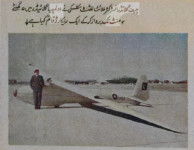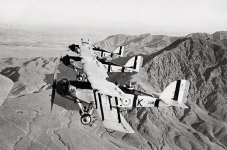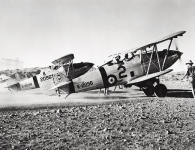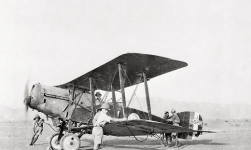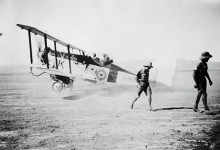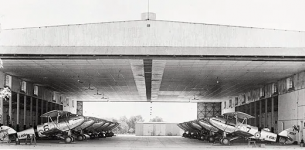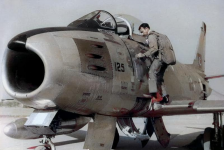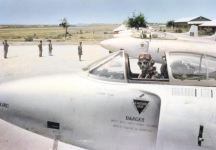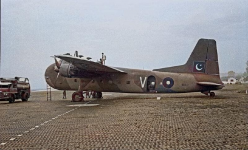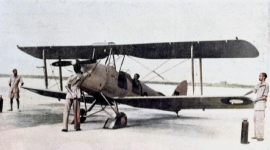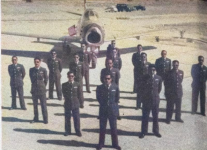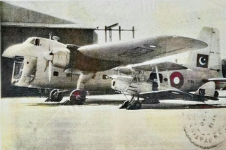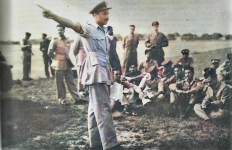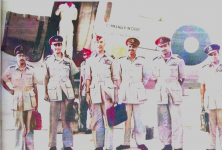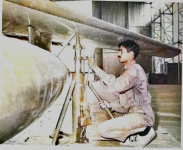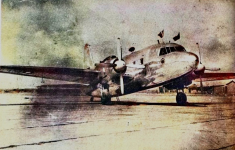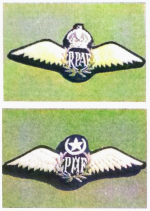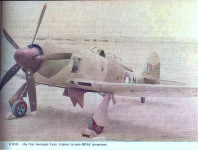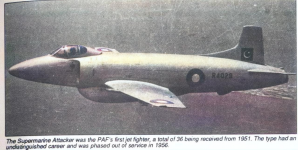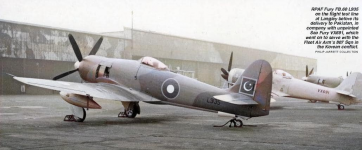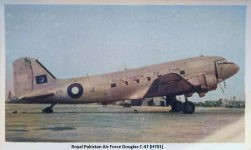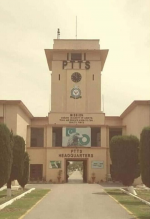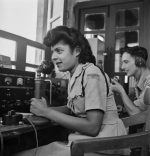- Jan 25, 2024
- 111,083
- 353
Interdiction of Supplies

One of the hugely successful missions of the war was an attack on Mukerian Railway Station. On 15 December, Wg Cdr Hakimullah was tasked to lead a four-ship mission to attack Bhangala Railway Station on Jalandhar-Pathankot railway line. After pulling up for the attack, he was dismayed to discover that there was no rolling stock in sight, but he decided to try his luck further south along the railway line.
Having flown a mere 30 seconds, he overflew Mukerian Railway Station which was bustling with trains. Peeling off into the attack pattern, the four Mirages set themselves for single-pass dive attacks with two 750-lb bombs each. According to Hakimullah's estimate, there were at least 100 freight bogies latched to different trains berthed adjacent to each other. The Mirages released their bombs one by one, though No 4, who had hung ordnance, pulled off dry. The impact of the bombs on fuel and ammunition laden trains was so furious that the blasts shook the aircraft; No 2's drop tanks sheared off with the shock wave but he was able to fly back without any further damage. The Mirages had so far been striking at shallow targets, but with the time for the main offensive running out, it was decided to use them more audaciously. It was ironic that one of the most significant interdiction missions was also the one and only flown by Mirages, before the curtain fell two days later.
Drop Scene
Pakistan Army's plan in the west called for the beginning of offensive operations five or six days after an Indian attack in the east. These, however, were meant to be secondary operations, essentially distractions, designed to fix the enemy and to divert his attention away from the intended site of the main attack by II Corps. With one armoured and two infantry divisions, II Corps was to strike into India from the Bahawalnagar area approximately three days after the secondary attacks. II Corps was to drive east to cross the international border, before turning to the northeast to push for Bhatinda and wishfully, beyond. It was expected that most of India's armoured reserves would have become embroiled in Pakistan's defences in the Shakargarh salient during this three-day interval between the secondary attacks and the main effort. After much prodding by the Army's field formation commanders as well as the PAF C-in-C, the vacillating GHQ reluctantly issued orders for II Corps to shift to its forward assembly areas on 14 December; elements of 1 Armoured Division began to move the following day. By this time, however, the other major component of II Corps ie, 33 Division, had already been detached to reinforce the beleaguered I Corps in the north and 18 Division in the south, where things were not going well for the Pakistan Army. A
s a consequence, II Corps was deprived of almost one third of its striking power before the offensive had even begun. On the evening of 16 December, however, new instructions arrived from GHQ, "freezing all movements" until further notice. Following capitulation of forces in the Eastern Wing, Pakistan accepted a cease fire on 17 December. Mirages – which were expected to reduce the IAF's weight of attack by neutralising 4-5 IAF airfields once the main offensive was underway – could, thus, not be utilised for the critical task that had been meticulously planned for months.
Report Card
During the 14-day war, Mirages flew a total of 390 sorties which was 13% of PAF's overall war effort of 2,955 sorties. [5] For a relatively new and modern weapon system, the Mirage achieved a modest aircraft Utilisation Rate of 1.6 sorties per aircraft per day during the war. [4] While it fell short of the planned 2.2 daily sorties, it reflected a cautious conduct of the war whereby the PAF was held back, so that everything could be thrown in during the army's main offensive which, in the event, never came through. Wg Cdr Hakimullah, who very ably commanded the Mirage squadron during the war, and also led several dangerous missions in enemy territory, was awarded the Sitara-i-Jur'at (Star of Valour). That coveted award also went to Sqn Ldr Farooq Umar, the senior flight commander of the squadron, who had flown many useful photo recce missions in enemy areas infested with patrolling fighters. The three pilots who shot down IAF aircraft were content with having joined the elite club of fighter pilots with aerial kills. A month after the war, the PAF was able to line up 22 Mirages for all to see on the tarmac at Sargodha, while the 23rd Mirage was under maintenance in a hangar.[6] The impressive sight belied claims of any losses that had been incurred by the Mirage fleet during the war.
____________________
[1] The Canberra's 'Orange Putter' tail warning radar (an active device) was prone to picking up ground clutter, and was usually turned off by the pilots at lower altitudes. It is likely that Sasoon had also turned it off, to avoid false alarms that would have been triggered over the hilly terrain.
[2] Official PAF Records.
[3] Ibid.
[4] Ibid.
[5] Utilisation Rate is based on an average aircraft serviceability of 75%. The Mirage-III wartime UR is calculated thus: UR = 395 sorties ÷ 17 aircraft ÷ 14 days = 1.6.
[6] A picture of the lined-up Mirages appeared in Air Enthusiast, May 1972 issue.
This article was published in Defence Journal, May 2009 issue, and Shaheen - Journal of the Pakistan Air Force, Vol 60.

One of the hugely successful missions of the war was an attack on Mukerian Railway Station. On 15 December, Wg Cdr Hakimullah was tasked to lead a four-ship mission to attack Bhangala Railway Station on Jalandhar-Pathankot railway line. After pulling up for the attack, he was dismayed to discover that there was no rolling stock in sight, but he decided to try his luck further south along the railway line.
Having flown a mere 30 seconds, he overflew Mukerian Railway Station which was bustling with trains. Peeling off into the attack pattern, the four Mirages set themselves for single-pass dive attacks with two 750-lb bombs each. According to Hakimullah's estimate, there were at least 100 freight bogies latched to different trains berthed adjacent to each other. The Mirages released their bombs one by one, though No 4, who had hung ordnance, pulled off dry. The impact of the bombs on fuel and ammunition laden trains was so furious that the blasts shook the aircraft; No 2's drop tanks sheared off with the shock wave but he was able to fly back without any further damage. The Mirages had so far been striking at shallow targets, but with the time for the main offensive running out, it was decided to use them more audaciously. It was ironic that one of the most significant interdiction missions was also the one and only flown by Mirages, before the curtain fell two days later.
Drop Scene
Pakistan Army's plan in the west called for the beginning of offensive operations five or six days after an Indian attack in the east. These, however, were meant to be secondary operations, essentially distractions, designed to fix the enemy and to divert his attention away from the intended site of the main attack by II Corps. With one armoured and two infantry divisions, II Corps was to strike into India from the Bahawalnagar area approximately three days after the secondary attacks. II Corps was to drive east to cross the international border, before turning to the northeast to push for Bhatinda and wishfully, beyond. It was expected that most of India's armoured reserves would have become embroiled in Pakistan's defences in the Shakargarh salient during this three-day interval between the secondary attacks and the main effort. After much prodding by the Army's field formation commanders as well as the PAF C-in-C, the vacillating GHQ reluctantly issued orders for II Corps to shift to its forward assembly areas on 14 December; elements of 1 Armoured Division began to move the following day. By this time, however, the other major component of II Corps ie, 33 Division, had already been detached to reinforce the beleaguered I Corps in the north and 18 Division in the south, where things were not going well for the Pakistan Army. A
s a consequence, II Corps was deprived of almost one third of its striking power before the offensive had even begun. On the evening of 16 December, however, new instructions arrived from GHQ, "freezing all movements" until further notice. Following capitulation of forces in the Eastern Wing, Pakistan accepted a cease fire on 17 December. Mirages – which were expected to reduce the IAF's weight of attack by neutralising 4-5 IAF airfields once the main offensive was underway – could, thus, not be utilised for the critical task that had been meticulously planned for months.
Report Card
During the 14-day war, Mirages flew a total of 390 sorties which was 13% of PAF's overall war effort of 2,955 sorties. [5] For a relatively new and modern weapon system, the Mirage achieved a modest aircraft Utilisation Rate of 1.6 sorties per aircraft per day during the war. [4] While it fell short of the planned 2.2 daily sorties, it reflected a cautious conduct of the war whereby the PAF was held back, so that everything could be thrown in during the army's main offensive which, in the event, never came through. Wg Cdr Hakimullah, who very ably commanded the Mirage squadron during the war, and also led several dangerous missions in enemy territory, was awarded the Sitara-i-Jur'at (Star of Valour). That coveted award also went to Sqn Ldr Farooq Umar, the senior flight commander of the squadron, who had flown many useful photo recce missions in enemy areas infested with patrolling fighters. The three pilots who shot down IAF aircraft were content with having joined the elite club of fighter pilots with aerial kills. A month after the war, the PAF was able to line up 22 Mirages for all to see on the tarmac at Sargodha, while the 23rd Mirage was under maintenance in a hangar.[6] The impressive sight belied claims of any losses that had been incurred by the Mirage fleet during the war.
____________________
[1] The Canberra's 'Orange Putter' tail warning radar (an active device) was prone to picking up ground clutter, and was usually turned off by the pilots at lower altitudes. It is likely that Sasoon had also turned it off, to avoid false alarms that would have been triggered over the hilly terrain.
[2] Official PAF Records.
[3] Ibid.
[4] Ibid.
[5] Utilisation Rate is based on an average aircraft serviceability of 75%. The Mirage-III wartime UR is calculated thus: UR = 395 sorties ÷ 17 aircraft ÷ 14 days = 1.6.
[6] A picture of the lined-up Mirages appeared in Air Enthusiast, May 1972 issue.
This article was published in Defence Journal, May 2009 issue, and Shaheen - Journal of the Pakistan Air Force, Vol 60.


